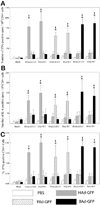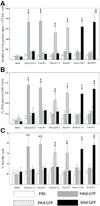Evaluation of cross-reactive cell-mediated immune responses among human, bovine and porcine adenoviruses
- PMID: 20164856
- PMCID: PMC2869393
- DOI: 10.1038/gt.2010.1
Evaluation of cross-reactive cell-mediated immune responses among human, bovine and porcine adenoviruses
Abstract
The absence of preexisting immunity against porcine adenovirus (Ad) serotype 3 (PAd3) and bovine Ad serotype 3 (BAd3) in humans makes them attractive alternatives to human Ad serotype 5 (HAd5) vectors. To determine whether there is significant cross-reactivity among HAd5, BAd3 and PAd3 at the level of cell-mediated immune responses, BALB/c mice were inoculated intraperitoneally with wild-type (WT) or replication-defective (RD) HAd5, BAd3 or PAd3. After 35 days of the first inoculation, cross-reactive CD8+ cytotoxic T cells, as well as CD4+ Th1- and Th2-helper T cells, in the spleen were analyzed by enzyme-linked-immunospot, flow cytometry and cytotoxic T lymphocyte assays. Virus-neutralization assays were used to evaluate humoral cross-reactivity. CD8+ or CD4+ T cells primed with WT or RD HAd5, PAd3 or BAd3 showed significant (P<0.005) reactivity with homologous Ad antigens, whereas only minimal cross-reactivity was observed on stimulation with heterologous Ad antigens. Ad-neutralizing antibodies were found to be homologous Ad specific. Overall, these results suggest that there is no significant immunological cross-reactivity among HAd5, BAd3 and PAd3, thereby supporting the rationale for the use of BAd3 and PAd3 as alternative HAd vectors to circumvent anti-HAd immunity in humans.
Figures


Similar articles
-
Circumvention of vector-specific neutralizing antibody response by alternating use of human and non-human adenoviruses: implications in gene therapy.Virology. 2000 Jun 20;272(1):159-67. doi: 10.1006/viro.2000.0350. Virology. 2000. PMID: 10873758
-
Porcine adenoviral vectors evade preexisting humoral immunity to adenoviruses and efficiently infect both human and murine cells in culture.Virus Res. 2004 Oct;105(2):127-36. doi: 10.1016/j.virusres.2004.05.003. Virus Res. 2004. PMID: 15351486
-
Comparative transduction efficiencies of human and nonhuman adenoviral vectors in human, murine, bovine, and porcine cells in culture.Biochem Biophys Res Commun. 2005 Feb 18;327(3):960-6. doi: 10.1016/j.bbrc.2004.12.099. Biochem Biophys Res Commun. 2005. PMID: 15649439
-
Pre-existing immunity against Ad vectors: humoral, cellular, and innate response, what's important?Hum Vaccin Immunother. 2014;10(10):2875-84. doi: 10.4161/hv.29594. Hum Vaccin Immunother. 2014. PMID: 25483662 Free PMC article. Review.
-
Factors Which Contribute to the Immunogenicity of Non-replicating Adenoviral Vectored Vaccines.Front Immunol. 2020 May 19;11:909. doi: 10.3389/fimmu.2020.00909. eCollection 2020. Front Immunol. 2020. PMID: 32508823 Free PMC article. Review.
Cited by
-
Enhancement of mucosal innate and adaptive immunity following intranasal immunization of mice with a bovine adenoviral vector.Front Immunol. 2023 Nov 21;14:1305937. doi: 10.3389/fimmu.2023.1305937. eCollection 2023. Front Immunol. 2023. PMID: 38077380 Free PMC article.
-
An update on canine adenovirus type 2 and its vectors.Viruses. 2010 Sep;2(9):2134-2153. doi: 10.3390/v2092134. Epub 2010 Sep 27. Viruses. 2010. PMID: 21994722 Free PMC article.
-
A recombinant bovine adenoviral mucosal vaccine expressing mycobacterial antigen-85B generates robust protection against tuberculosis in mice.Cell Rep Med. 2021 Aug 17;2(8):100372. doi: 10.1016/j.xcrm.2021.100372. eCollection 2021 Aug 17. Cell Rep Med. 2021. PMID: 34467249 Free PMC article.
-
Bovine Adenoviral Vector-Based Platform for Vaccine Development.Vaccines (Basel). 2025 May 3;13(5):494. doi: 10.3390/vaccines13050494. Vaccines (Basel). 2025. PMID: 40432106 Free PMC article. Review.
-
Adenoviral Vector-Based Vaccine Platforms for Developing the Next Generation of Influenza Vaccines.Vaccines (Basel). 2020 Oct 1;8(4):574. doi: 10.3390/vaccines8040574. Vaccines (Basel). 2020. PMID: 33019589 Free PMC article. Review.
References
-
- Edelstein ML, Abedi MR, Wixon J, Edelstein RM. Gene therapy clinical trials worldwide 1989– 2004-an overview. J Gene Med. 2004;6:597–602. - PubMed
-
- Moffatt S, Hays J, HogenEsch H, Mittal SK. Circumvention of vector-specific neutralizing antibody response by alternating use of human and non-human adenoviruses: implications in gene therapy. Virology. 2000;272:159–167. - PubMed
Publication types
MeSH terms
Substances
Grants and funding
LinkOut - more resources
Full Text Sources
Other Literature Sources
Research Materials
Miscellaneous

